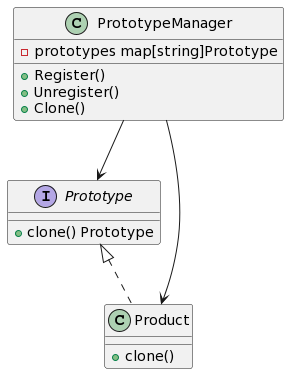1. 프로토타입 패턴이란
소프트웨어 개발에서 프로토타입 패턴은 새로운 객체를 생성하는 데 기존 객체를 복사하여 new 연산자를 사용하지 않는 생성 디자인 패턴입니다. 이 방법은 객체 간의 복제 관계를 활용하여 객체의 생성과 사용을 분리합니다.
2. 프로토타입 패턴의 특징 및 장점
- 특징:
- 런타임에서 동적으로 객체를 생성할 수 있습니다.
- 객체 생성 시간을 줄이고 시스템 성능을 향상시킵니다.
- 객체의 생성과 사용을 분리하여 관리와 확장을 쉽게 합니다.
- 장점:
- 객체 생성의 효율성을 향상시킵니다.
- 객체 생성 프로세스를 단순화합니다.
- 객체를 동적으로 증가 또는 감소시킬 수 있습니다.
3. Golang에서 프로토타입 패턴의 적용 시나리오
프로토타입 패턴은 다음 상황에 적합합니다:
- 객체 생성이 복잡하지만 기존 객체를 복사하여 객체를 생성하는 것이 더 효율적인 경우
- 새로운 개체 인스턴스를 직접 생성하는 대신 동적으로 개체를 생성하거나 복제해야 하는 경우
4. Golang에서 프로토타입 패턴의 구현
4.1. UML 클래스 다이어그램

4.2. 구현 단계 1: 프로토타입 인터페이스 생성
먼저, clone 메서드를 정의하는 프로토타입 인터페이스를 생성합니다.
type Prototype interface {
clone() Prototype
}
4.3. 구현 단계 2: 프로토타입 인터페이스를 사용하여 객체 생성 및 복제
4.3.1. 프로토타입 매니저 클래스 생성
프로토타입 매니저 클래스는 프로토타입 객체를 생성하고 관리하는 역할을 담당합니다.
type PrototypeManager struct {
prototypes map[string]Prototype
}
func NewPrototypeManager() *PrototypeManager {
return &PrototypeManager{
prototypes: make(map[string]Prototype),
}
}
func (pm *PrototypeManager) Register(name string, prototype Prototype) {
pm.prototypes[name] = prototype
}
func (pm *PrototypeManager) Unregister(name string) {
delete(pm.prototypes, name)
}
func (pm *PrototypeManager) Clone(name string) Prototype {
prototype, ok := pm.prototypes[name]
if ok {
return prototype.clone()
}
return nil
}
4.3.2. 프로토타입 매니저 클래스를 사용하여 객체 생성 및 복제
type Product struct {
name string
}
func (p *Product) clone() Prototype {
return &Product{
name: p.name,
}
}
func main() {
manager := NewPrototypeManager()
// 프로토타입 매니저 클래스에 프로토타입 객체 등록
manager.Register("productA", &Product{name: "Product A"})
// 프로토타입 매니저 클래스를 사용하여 객체 생성 및 복제
productA := manager.Clone("productA").(*Product)
fmt.Println(productA.name) // 출력: Product A
}
4.4. 구현 단계 3: 프로토타입 패턴 사용 시 고려 사항 및 모범 사례
프로토타입 패턴을 사용할 때 다음 사항에 유의해야 합니다:
- 객체 생성 비용이 높을 때 프로토타입 패턴을 사용하는 것이 적합하며, 객체를 복제하여 생성 시간을 절약할 수 있습니다.
- 복제된 객체가 원본과 일관성이 있는지 확인하기 위해 객체의 clone 메서드 구현에 유의해야 합니다.